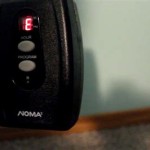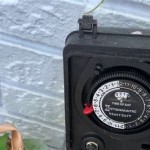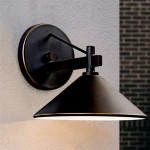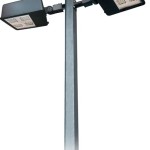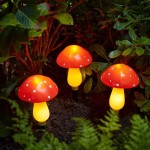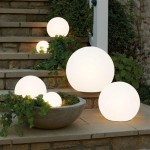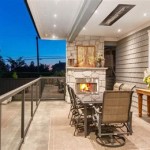How Many Watts for Outdoor Light?
Determining the appropriate wattage for outdoor lighting involves a multifaceted analysis that considers factors such as the intended purpose of the light fixture, the size of the area to be illuminated, and desired light intensity. Selecting the correct wattage is crucial for achieving optimal visibility and security, while also balancing energy efficiency and minimizing light pollution. This article will explore the various considerations involved in selecting the appropriate wattage for different outdoor lighting applications.
The term "wattage" refers to the amount of electrical power a light bulb or fixture consumes. It is a measure of energy consumption, not necessarily a direct indication of brightness. Light output, on the other hand, is measured in lumens. Traditionally, there was a more direct correlation between wattage and brightness when incandescent bulbs were the primary light source. However, with the advent of more energy-efficient lighting technologies like LED, the relationship has become less straightforward. Lower wattage LEDs can produce the same or even greater lumen output compared to higher wattage incandescent bulbs, making lumens the more relevant metric to consider when assessing brightness.
Understanding Lumens and Foot-candles
Before delving into specific wattage recommendations, it is essential to understand the concepts of lumens and foot-candles. Lumens, as mentioned earlier, represent the total amount of visible light emitted by a light source. A higher lumen value indicates a brighter light. Foot-candles, on the other hand, measure the illuminance or the amount of light falling on a surface. One foot-candle is equivalent to one lumen per square foot. The required foot-candle level varies depending on the application. For example, a pathway may only require a few foot-candles, while a security lighting application may need significantly more.
The relationship between lumens, foot-candles, and wattage is crucial when selecting outdoor lighting. While wattage provides an indication of energy consumption, lumens provide a measure of brightness, and foot-candles dictate the amount of light reaching the target area. To determine the necessary wattage, one must first determine the desired foot-candle level for the specific area and then calculate the required lumens based on the area's size and shape. Finally, the wattage can be selected based on the lumen output of the chosen light source. It's important to note that various online calculators and lighting design guides can aid in these calculations.
The efficiency of the light source also plays a crucial role. LEDs, for example, are significantly more efficient than incandescent bulbs, producing more lumens per watt. This means that a lower wattage LED can achieve the same brightness as a higher wattage incandescent bulb, leading to significant energy savings. Therefore, when considering wattage, one should also factor in the type of light source being used and its lumen-per-watt efficiency.
Wattage Recommendations for Different Outdoor Lighting Applications
The ideal wattage for outdoor lighting varies significantly depending on the specific application and intended purpose. Different outdoor areas require different levels of illumination to achieve the desired effect, whether it be safety, security, or ambiance. Below are wattage recommendations for some common outdoor lighting applications:
Pathway Lighting: Pathway lighting is typically used to provide safe passage along walkways and garden paths. The primary goal is to provide sufficient illumination to prevent tripping hazards and guide individuals safely. For pathway lighting, a lower wattage light source is usually sufficient. Typically, LED lights with a wattage of 2-5 watts per fixture are adequate for illuminating pathways. These lights should be spaced appropriately along the pathway to provide consistent and even illumination. The spacing will depend on the height of the fixture, with taller fixtures requiring greater spacing. The use of low-level lighting can create a calming and inviting ambiance while also minimizing light pollution.
Porch Lighting: Porch lights serve multiple purposes, including providing security, welcoming guests, and enhancing the aesthetic appeal of the home. The appropriate wattage for porch lighting depends on the size of the porch and the desired level of illumination. For a small porch, a single LED bulb with a wattage of 8-12 watts may be sufficient. For larger porches, two or more fixtures with a combined wattage of 16-24 watts may be necessary. The use of dimmers can allow for adjusting the light level to suit different needs and occasions. Consider the style of the house when selecting porch lighting to ensure it complements the overall design.
Security Lighting: Security lighting is intended to deter intruders and provide a sense of safety and security. For security lighting, a higher wattage light source is generally recommended. LED floodlights with a wattage of 20-50 watts are commonly used for security purposes. These lights should be placed strategically to illuminate key areas around the property, such as entrances, driveways, and vulnerable areas. Motion sensors can be used to activate security lights when motion is detected, providing an added layer of security and conserving energy. Consider the beam angle of the floodlight to ensure it covers the desired area effectively.
Landscape Lighting: Landscape lighting is used to highlight architectural features, trees, shrubs, and other elements of the landscape. The wattage for landscape lighting depends on the size and characteristics of the features being illuminated. Low-wattage LED spotlights, typically ranging from 3-7 watts, are commonly used to highlight individual plants or architectural details. For larger features, such as trees or walls, higher wattage spotlights, ranging from 7-12 watts, may be necessary. The use of color temperature can also enhance the aesthetic appeal of landscape lighting. Warmer color temperatures create a cozy and inviting ambiance, while cooler color temperatures provide a more modern and dramatic look.
Deck and Patio Lighting: Deck and patio lighting is intended to create a relaxed and inviting outdoor living space. The appropriate wattage for deck and patio lighting depends on the size of the area and the desired ambiance. Low-wattage LED string lights or recessed lighting, typically ranging from 1-3 watts per bulb, are commonly used for creating a warm and inviting atmosphere. For dining areas or areas where more task lighting is needed, higher wattage lights, ranging from 5-10 watts, may be necessary. The use of dimmers can allow for adjusting the light level to suit different activities and occasions. Consider the overall design of the deck or patio when selecting lighting to ensure it complements the existing style.
Garage Lighting: Outdoor garage lighting is crucial for safety and security. It ensures visibility when entering or exiting the garage, deters potential criminal activity, and illuminates the surrounding area. Typically, a bright and wide-reaching light is ideal. LED floodlights in the range of 30 to 70 watts are generally recommended. The exact wattage depends on the garage size and the surrounding area. Consider using motion-activated lights to save energy and provide added security. Proper placement above the garage door or on the sides of the garage is important to maximize effectiveness.
Factors to Consider When Choosing Wattage
Beyond the specific application, several other factors influence the optimal wattage selection for outdoor lighting. These considerations include the type of light source, the fixture design, the desired light level, and local regulations.
Type of Light Source: As previously mentioned, different types of light sources have varying lumen-per-watt efficiencies. LEDs are significantly more efficient than incandescent bulbs, allowing for lower wattage alternatives to achieve the same brightness. Halogen bulbs fall somewhere in between. When selecting lighting, it is essential to consider the efficiency of the light source to minimize energy consumption while still achieving the desired light level. The lifespan of the bulb is also a factor. LEDs generally have a significantly longer lifespan than other types of bulbs, reducing the frequency of replacements.
Fixture Design: The design of the light fixture can significantly impact the amount of light emitted and the direction it is cast. Fixtures with reflectors or lenses can concentrate the light, allowing for lower wattage bulbs to achieve the same illuminance. Conversely, fixtures with opaque shades may require higher wattage bulbs to compensate for the light that is blocked. Consider the fixture's design when selecting wattage to ensure that the desired light level is achieved without excessive energy consumption. The material of the fixture also plays a role in its durability and resistance to weather elements. Choose durable, weather-resistant materials for outdoor lights.
Desired Light Level and Color Temperature: Different outdoor areas require different light levels to achieve the desired effect. Areas intended for relaxation may benefit from lower light levels and warmer color temperatures, while areas intended for task lighting or security may require higher light levels and cooler color temperatures. Consider the intended purpose of the area when selecting wattage to ensure that the light level and color temperature are appropriate. Color temperature is measured in Kelvin (K). Lower Kelvin values (e.g., 2700K) indicate warmer (yellower) light, while higher Kelvin values (e.g., 5000K) indicate cooler (bluer) light.
Local Regulations: Some municipalities have regulations regarding outdoor lighting, including restrictions on wattage, lumen output, and light trespass. It is essential to check local regulations before installing outdoor lighting to ensure compliance. These regulations are often aimed at minimizing light pollution and protecting the environment. Failure to comply with local regulations can result in fines or legal action.
Light Pollution: Light pollution is an increasing concern, and selecting the right wattage is one way to minimize its impact. Using only the necessary amount of light, directing light downwards, and using shielded fixtures can all help to reduce light pollution. Consider using fixtures with full cutoff shields, which prevent light from being emitted upward. This helps to keep light focused where it is needed and reduces glare. Dark Sky compliant fixtures are designed to minimize light pollution.
Cost Considerations: While LED lighting is generally more expensive upfront, it delivers significant savings over time through lower energy consumption and longer lifespans. Consider the total cost of ownership, including the initial cost of the fixture, energy consumption, and replacement costs, when selecting outdoor lighting. Energy-efficient lighting can also qualify for rebates or incentives, further reducing the overall cost.
Ultimately, determining the appropriate wattage for outdoor lighting requires careful consideration of various factors, including the intended purpose of the light fixture, the size of the area to be illuminated, desired light intensity, and the type of light source used. By understanding the relationship between wattage, lumens, and foot-candles, and by considering the various factors discussed in this article, one can select the optimal wattage for any outdoor lighting application, achieving the desired balance between visibility, security, energy efficiency, and aesthetics.

Led Flood Lights What You Need To Know

How Many Lumens Outdoor Landscape Lights Need To Work Well

How Many Lumens Do You Need For Outdoor Lighting

Everything To Know About Bulbs For Landscape Lighting

Led Flood Lights What You Need To Know

How Many Lumens Do You Need For Outdoor Lighting

This Is The Best Wattage For Outdoor Lights Around Homes

What Wattage Is Best For Outdoor Flood Lights Ledmyplace

The Ultimate Guide To Outdoor Lighting How Many Lumens And Watts Do You Need Govee

How Many Lumens Are Needed For Outdoor Lighting The Home Depot
